+ Open data
Open data
- Basic information
Basic information
| Entry | Database: PDB / ID: 1x11 | ||||||
|---|---|---|---|---|---|---|---|
| Title | X11 PTB DOMAIN | ||||||
 Components Components |
| ||||||
 Keywords Keywords | COMPLEX (PEPTIDE BINDING MODULE/PEPTIDE) / COMPLEX (PEPTIDE BINDING MODULE-PEPTIDE) / PTB DOMAIN / COMPLEX (PEPTIDE BINDING MODULE-PEPTIDE) complex | ||||||
| Function / homology |  Function and homology information Function and homology informationgamma-aminobutyric acid secretion / Dopamine Neurotransmitter Release Cycle / amyloid-beta complex / growth cone lamellipodium / cellular response to norepinephrine stimulus / growth cone filopodium / microglia development / collateral sprouting in absence of injury / Formyl peptide receptors bind formyl peptides and many other ligands / axo-dendritic transport ...gamma-aminobutyric acid secretion / Dopamine Neurotransmitter Release Cycle / amyloid-beta complex / growth cone lamellipodium / cellular response to norepinephrine stimulus / growth cone filopodium / microglia development / collateral sprouting in absence of injury / Formyl peptide receptors bind formyl peptides and many other ligands / axo-dendritic transport / regulation of Wnt signaling pathway / regulation of synapse structure or activity / axon midline choice point recognition / glutamate secretion / astrocyte activation involved in immune response / Assembly and cell surface presentation of NMDA receptors / NMDA selective glutamate receptor signaling pathway / regulation of spontaneous synaptic transmission / mating behavior / Neurexins and neuroligins / growth factor receptor binding / peptidase activator activity / Golgi-associated vesicle / PTB domain binding / positive regulation of amyloid fibril formation / Insertion of tail-anchored proteins into the endoplasmic reticulum membrane / Lysosome Vesicle Biogenesis / astrocyte projection / neuron remodeling / Deregulated CDK5 triggers multiple neurodegenerative pathways in Alzheimer's disease models / nuclear envelope lumen / dendrite development / positive regulation of protein metabolic process / TRAF6 mediated NF-kB activation / Advanced glycosylation endproduct receptor signaling / signaling receptor activator activity / negative regulation of long-term synaptic potentiation / modulation of excitatory postsynaptic potential / The NLRP3 inflammasome / main axon / transition metal ion binding / intracellular copper ion homeostasis / regulation of multicellular organism growth / ECM proteoglycans / regulation of presynapse assembly / positive regulation of T cell migration / neuronal dense core vesicle / Purinergic signaling in leishmaniasis infection / positive regulation of chemokine production / cellular response to manganese ion / Notch signaling pathway / clathrin-coated pit / presynaptic active zone membrane / extracellular matrix organization / neuron projection maintenance / Mitochondrial protein degradation / astrocyte activation / presynaptic modulation of chemical synaptic transmission / ionotropic glutamate receptor signaling pathway / positive regulation of calcium-mediated signaling / positive regulation of mitotic cell cycle / axonogenesis / protein serine/threonine kinase binding / response to interleukin-1 / platelet alpha granule lumen / cellular response to copper ion / cellular response to cAMP / positive regulation of glycolytic process / central nervous system development / endosome lumen / positive regulation of interleukin-1 beta production / dendritic shaft / trans-Golgi network membrane / positive regulation of long-term synaptic potentiation / adult locomotory behavior / learning / positive regulation of JNK cascade / Post-translational protein phosphorylation / locomotory behavior / intracellular protein transport / serine-type endopeptidase inhibitor activity / microglial cell activation / positive regulation of non-canonical NF-kappaB signal transduction / TAK1-dependent IKK and NF-kappa-B activation / regulation of long-term neuronal synaptic plasticity / cellular response to nerve growth factor stimulus / recycling endosome / synapse organization / visual learning / response to lead ion / positive regulation of interleukin-6 production / Golgi lumen / Schaffer collateral - CA1 synapse / cognition / multicellular organism growth / Regulation of Insulin-like Growth Factor (IGF) transport and uptake by Insulin-like Growth Factor Binding Proteins (IGFBPs) / endocytosis / cellular response to amyloid-beta / neuron projection development / positive regulation of inflammatory response Similarity search - Function | ||||||
| Biological species |  Homo sapiens (human) Homo sapiens (human) | ||||||
| Method |  X-RAY DIFFRACTION / X-RAY DIFFRACTION /  MAD / Resolution: 2.5 Å MAD / Resolution: 2.5 Å | ||||||
 Authors Authors | Lee, C.-H. / Zhang, Z. / Kuriyan, J. | ||||||
 Citation Citation |  Journal: EMBO J. / Year: 1997 Journal: EMBO J. / Year: 1997Title: Sequence-specific recognition of the internalization motif of the Alzheimer's amyloid precursor protein by the X11 PTB domain. Authors: Zhang, Z. / Lee, C.H. / Mandiyan, V. / Borg, J.P. / Margolis, B. / Schlessinger, J. / Kuriyan, J. | ||||||
| History |
|
- Structure visualization
Structure visualization
| Structure viewer | Molecule:  Molmil Molmil Jmol/JSmol Jmol/JSmol |
|---|
- Downloads & links
Downloads & links
- Download
Download
| PDBx/mmCIF format |  1x11.cif.gz 1x11.cif.gz | 90.2 KB | Display |  PDBx/mmCIF format PDBx/mmCIF format |
|---|---|---|---|---|
| PDB format |  pdb1x11.ent.gz pdb1x11.ent.gz | 69 KB | Display |  PDB format PDB format |
| PDBx/mmJSON format |  1x11.json.gz 1x11.json.gz | Tree view |  PDBx/mmJSON format PDBx/mmJSON format | |
| Others |  Other downloads Other downloads |
-Validation report
| Summary document |  1x11_validation.pdf.gz 1x11_validation.pdf.gz | 423.2 KB | Display |  wwPDB validaton report wwPDB validaton report |
|---|---|---|---|---|
| Full document |  1x11_full_validation.pdf.gz 1x11_full_validation.pdf.gz | 432 KB | Display | |
| Data in XML |  1x11_validation.xml.gz 1x11_validation.xml.gz | 8.9 KB | Display | |
| Data in CIF |  1x11_validation.cif.gz 1x11_validation.cif.gz | 13.2 KB | Display | |
| Arichive directory |  https://data.pdbj.org/pub/pdb/validation_reports/x1/1x11 https://data.pdbj.org/pub/pdb/validation_reports/x1/1x11 ftp://data.pdbj.org/pub/pdb/validation_reports/x1/1x11 ftp://data.pdbj.org/pub/pdb/validation_reports/x1/1x11 | HTTPS FTP |
-Related structure data
- Links
Links
- Assembly
Assembly
| Deposited unit | 
| ||||||||
|---|---|---|---|---|---|---|---|---|---|
| 1 |
| ||||||||
| 2 | 
| ||||||||
| 3 | 
| ||||||||
| Unit cell |
| ||||||||
| Noncrystallographic symmetry (NCS) | NCS oper: (Code: given Matrix: (0.28, -0.569, 0.773), Vector: |
- Components
Components
| #1: Protein | Mass: 19801.256 Da / Num. of mol.: 2 / Fragment: PTB DOMAIN Source method: isolated from a genetically manipulated source Source: (gene. exp.)  Homo sapiens (human) / Production host: Homo sapiens (human) / Production host:  #2: Protein/peptide | Mass: 1637.723 Da / Num. of mol.: 2 Source method: isolated from a genetically manipulated source References: UniProt: P05067 #3: Water | ChemComp-HOH / | Has protein modification | Y | |
|---|
-Experimental details
-Experiment
| Experiment | Method:  X-RAY DIFFRACTION / Number of used crystals: 1 X-RAY DIFFRACTION / Number of used crystals: 1 |
|---|
- Sample preparation
Sample preparation
| Crystal | Density Matthews: 2.52 Å3/Da / Density % sol: 51.19 % | ||||||||||||||||||||||||
|---|---|---|---|---|---|---|---|---|---|---|---|---|---|---|---|---|---|---|---|---|---|---|---|---|---|
| Crystal grow | pH: 7.5 / Details: pH 7.5 | ||||||||||||||||||||||||
| Crystal grow | *PLUS Temperature: 21 ℃ / pH: 6.5 / Method: vapor diffusion, hanging drop | ||||||||||||||||||||||||
| Components of the solutions | *PLUS
|
-Data collection
| Diffraction | Mean temperature: 100 K |
|---|---|
| Diffraction source | Source:  ROTATING ANODE / Type: RIGAKU RUH2R / Wavelength: 1.5418 ROTATING ANODE / Type: RIGAKU RUH2R / Wavelength: 1.5418 |
| Detector | Type: RIGAKU / Detector: IMAGE PLATE / Date: Aug 1, 1996 / Details: MIRRORS |
| Radiation | Monochromatic (M) / Laue (L): M / Scattering type: x-ray |
| Radiation wavelength | Wavelength: 1.5418 Å / Relative weight: 1 |
| Reflection | Resolution: 2.4→30 Å / Num. obs: 97157 / % possible obs: 99.3 % / Redundancy: 5.5 % / Rsym value: 0.054 / Net I/σ(I): 27.6 |
| Reflection shell | Resolution: 2.4→2.49 Å / Mean I/σ(I) obs: 5.1 / Rsym value: 0.302 / % possible all: 99.2 |
| Reflection | *PLUS Num. obs: 17790 / Num. measured all: 97157 / Rmerge(I) obs: 0.054 |
| Reflection shell | *PLUS % possible obs: 99.2 % / Rmerge(I) obs: 0.302 |
- Processing
Processing
| Software |
| ||||||||||||||||||||||||||||||||||||||||||||||||||||||||||||
|---|---|---|---|---|---|---|---|---|---|---|---|---|---|---|---|---|---|---|---|---|---|---|---|---|---|---|---|---|---|---|---|---|---|---|---|---|---|---|---|---|---|---|---|---|---|---|---|---|---|---|---|---|---|---|---|---|---|---|---|---|---|
| Refinement | Method to determine structure:  MAD / Resolution: 2.5→6 Å / Isotropic thermal model: RESTRAINED / Cross valid method: THROUGHOUT / σ(F): 2 MAD / Resolution: 2.5→6 Å / Isotropic thermal model: RESTRAINED / Cross valid method: THROUGHOUT / σ(F): 2 Details: MISSING RESIDUES CORRESPOND TO DISORDERED REGIONS THAT WERE NOT MODELLED.
| ||||||||||||||||||||||||||||||||||||||||||||||||||||||||||||
| Displacement parameters | Biso mean: 42.3 Å2 | ||||||||||||||||||||||||||||||||||||||||||||||||||||||||||||
| Refinement step | Cycle: LAST / Resolution: 2.5→6 Å
| ||||||||||||||||||||||||||||||||||||||||||||||||||||||||||||
| Refine LS restraints |
| ||||||||||||||||||||||||||||||||||||||||||||||||||||||||||||
| Xplor file |
| ||||||||||||||||||||||||||||||||||||||||||||||||||||||||||||
| Software | *PLUS Name:  X-PLOR / Version: 3.8 / Classification: refinement X-PLOR / Version: 3.8 / Classification: refinement | ||||||||||||||||||||||||||||||||||||||||||||||||||||||||||||
| Refinement | *PLUS Rfactor all: 0.232 / Rfactor obs: 0.212 / Rfactor Rfree: 0.303 | ||||||||||||||||||||||||||||||||||||||||||||||||||||||||||||
| Solvent computation | *PLUS | ||||||||||||||||||||||||||||||||||||||||||||||||||||||||||||
| Displacement parameters | *PLUS | ||||||||||||||||||||||||||||||||||||||||||||||||||||||||||||
| LS refinement shell | *PLUS % reflection Rfree: 10 % |
 Movie
Movie Controller
Controller





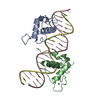
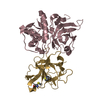
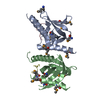
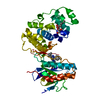
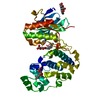
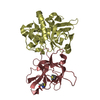
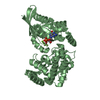

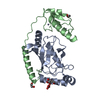
 PDBj
PDBj


















